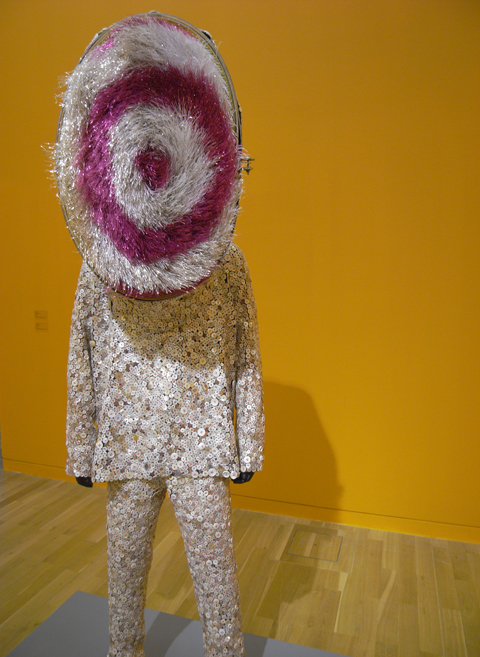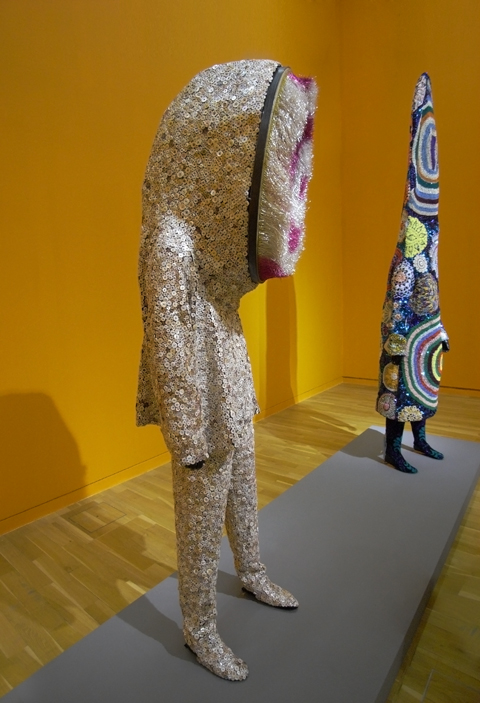The 2010 summer collection by Dutch designers Viktor & Rolf was billed as a "chain-saw massacre". What remained of the fashion show, praised for being sensational, now seems pretty drab when viewed at Kunstmuseum Wolfsburg: Wedge-shaped dents and circular holes in a voluminous net-lace dress, sawn out with great precision. Here, no Stefan Balkenhol had to labor to chisel away hard wood; mysterious or even auratic traces were not left by the collision of a rough machine and the fine material on the catwalk. But the close encounter of the calculating kind could have been a good reason to address that "mechanical couture" which was recently presented in all its facets in a Ron Arad show by the design museum in Holon, Israel: individual bespoke products fresh from the 3D scanner, intelligent fabric implants and eccentric shoe models off the conveyor belt. That is luxury clothing, quality fashion that results from the interaction of computer-assisted production and individual craftsmanship. A bizarre symbiosis.
When compared with this, the cut-out peekaboo holes in Wolfsburg seem somewhat petty. They are supposed to offer a view of that zone "between skin and dress" in which "art & fashion" meet, or so the opinion of curator Annelie Lütgens. With the exception of the naked alabaster flesh of the standardized mannequins, there's actually little to be seen. And nothing to be felt. Yet the real art and stunning sensuality can first be felt if you yourself don the items, the tribal costumes musician Nick Cave has dreamed up, made of a puzzle of thousands of buttons, or the flowing wig-cloak reminiscent of Samson and created by Lady Gaga's stylist Charlie le Mindu. Wearing Caves' button outfit anyone out for a stroll would be surrounded by soft tingling and tangling accompanying music - but no one is allowed to experience it. As the problem of fashion in the museum is that it is all too much a matter of the statuary, at best placing exquisitely equipped clothes horses on view.
Naomi Filmer certainly drew conclusions from this, but did not opt for the rip cord: In an uninspiring volte face the jewelry designer brings together three plaster designs and one cast bronze (i.e., pure art) under the heading of "Atemvolumen" (volume of breath). The stylized chests or larynxs each reflect the state of "collect", "stack", "swallow" and "release". But words alone do not suffice for a metaphysics, and like Damien Hirst's skull made of thousands of diamonds, inflated designer jewelry does not create a sculpture. There's an absence of movement, of dialectical tension as: "When we take a breath we enjoy two blessings, we draw in air and we release air, the one creates pressure, the other refreshes."
That is what occurred to Goethe on the subject of gasping for breath. The classic verse provides a marvelously simple pattern for the distribution of the roles of art and fashion: the one creates pressure, the other refreshes - and protects at the same time. Because why should fashion of all things debate or even cast into question comfort or even physical integrity? In Wolfsburg, the idea is to "make unusual visual discoveries and criticize the customary ideals of beauty". Yet museum visitors do not get the opportunity to take up the aesthetic/physiological challenges, such as those posed by the wooden skirts by Rei Kawakubo's "Comme des Garcons" or the porcelain dress by Maison Martin Margiela.
Only the beginner's course at Viktor & Rolf altar to fragrance gets a little under your skin. The unobtrusive rotunda is permeated by the odor of "Alternative No. 1", cheap tomato essence tickles the sensitive nose. However, this olfactory final chord, presented within the dull twilight of a plywood structure, has zip to do with the brash announcement that there's a "study of the relationship of skin and clothing, of envelope and public appearance". Yet the curators consider it the pinnacle of critique, as an inquiry into the hard economic fact that fashion designers earn the money for their seasonal products that often make a loss and do not spare resources - with fragrances. Many of these bestsellers draw additional added value from the flacons, designed by artists. This is referenced by Roman Polanski's ad clip for a fictitious fragrance and (in a conventional museum display case) the arrangement with Elsa Schiaparelli's "Snuff pour Monsieur" packaging and a glass pipe, that is no doubt not a pipe but only a touch of Magritte, a fleeting pinch of Foucault.
But like the way that citations are thrown in, any mentions of cultural history are no more than incidental. Alongside Christophe Coppens' "Dream Your Dream Collection" with his "deer cape" and his "body hat" whose outsized shadows are staged against colorful museum walls lies a forlorn wax children's shoe by Robert Gober. And, from the edge, a pink plush skull by Louise Bourgeois looks on at this fashion show that is being agreeably sold as art. And there is no movement at all in the opposite direction, absolutely no impulses are being sent out from fashion to art. Even the leather skins by Dai Rees that dangle from the ceiling like the torsos of ancient warriors only call to mind Egon Kalinowski. The latter could be seen as the Nestor of leather art. After all, it was decades ago when he made his creations from transmission belts and animal skins. And this artist still knows how to wear the leather waistcoats he has tailored himself with an incomparably lordly dignity. Indeed, it is not what you wear, but how you wear it, something that can be demonstrated on the street or at social occasions but not at a museum.
A catalog with essays by Annelie Lütgens, Richard Martin and José Teunissen will soon be published by Kerber Verlag.
Art & Fashion. Between Skin and Clothing
From March 5 - August 7, 2011
Kunstmuseum Wolfsburg
www.kunstmuseum-wolfsburg.de
 Wolfsburg’s current exhibition “Art & Fashion. Between skin and clothing”, Photo: Claudia Mucha, 2011
Wolfsburg’s current exhibition “Art & Fashion. Between skin and clothing”, Photo: Claudia Mucha, 2011
 Exhibition view
Exhibition view
 Exhibition view
Exhibition view
 Exhibition view
Exhibition view



 Naomi Filmer "Orchid Neck Piece", 2008, Foto: Naomi Filmer
Naomi Filmer "Orchid Neck Piece", 2008, Foto: Naomi Filmer


 Viktor & Rolf "Maryna", Collektion "The Fashion Show", Fall/Winter 2007-2008, Foto: Peter Stigler
Viktor & Rolf "Maryna", Collektion "The Fashion Show", Fall/Winter 2007-2008, Foto: Peter Stigler
 Christophe Coppens "Deer Cape", aus der Kollektion "Dream Your Dream", Winter 2005, Foto: Marc Tops
Christophe Coppens "Deer Cape", aus der Kollektion "Dream Your Dream", Winter 2005, Foto: Marc Tops
 Walter van Beirendonck "Green Beard", aus der "Explicit Collection", Spring/Sommer 2009, Foto: Ronald Stoops
Walter van Beirendonck "Green Beard", aus der "Explicit Collection", Spring/Sommer 2009, Foto: Ronald Stoops
 Fashion show by Walter Van Beirendonck, Stephen Jones, “The Bee” Sex Clown collection summer 2008, Sammlung/collection Boijmans Van Beuningen
Fashion show by Walter Van Beirendonck, Stephen Jones, “The Bee” Sex Clown collection summer 2008, Sammlung/collection Boijmans Van Beuningen
 Exhibition view of Walter Van Beirendonck, Stephen Jones “The Bee”
Exhibition view of Walter Van Beirendonck, Stephen Jones “The Bee”
 Exhibition view
Exhibition view
 Exhibition view
Exhibition view
 Viktor & Rolf "The Chainsaw Massacre", Spring 2010, Foto: © Peter Stigter
Viktor & Rolf "The Chainsaw Massacre", Spring 2010, Foto: © Peter Stigter
 Viktor & Rolf "The Chainsaw Massacre", Spring 2010, Foto: © Peter Stigter
Viktor & Rolf "The Chainsaw Massacre", Spring 2010, Foto: © Peter Stigter
 Charlie Le Mindu "The Red Wall", Fall/Winter 2009/10, Foto: Charlie Le Mindu
Charlie Le Mindu "The Red Wall", Fall/Winter 2009/10, Foto: Charlie Le Mindu



 Maison Martin Margiela "Gilet en porceleine", Fall/Winter 1989/90, Foto: Bob Goedewaagen
Maison Martin Margiela "Gilet en porceleine", Fall/Winter 1989/90, Foto: Bob Goedewaagen


